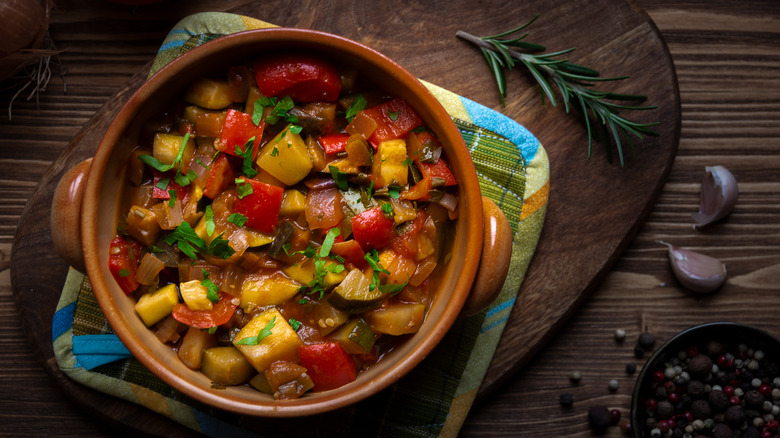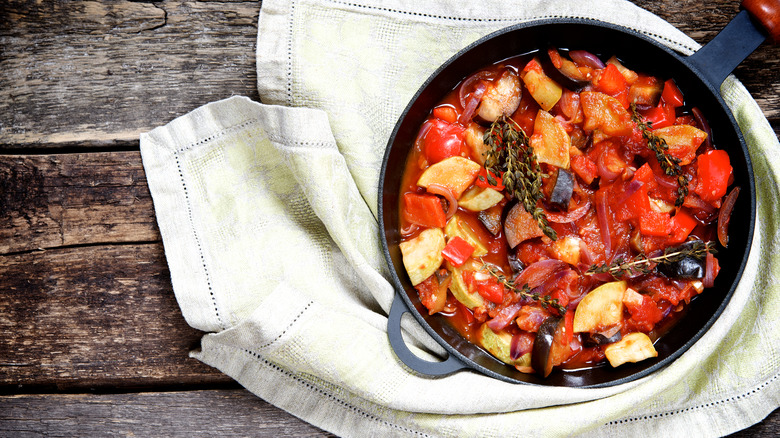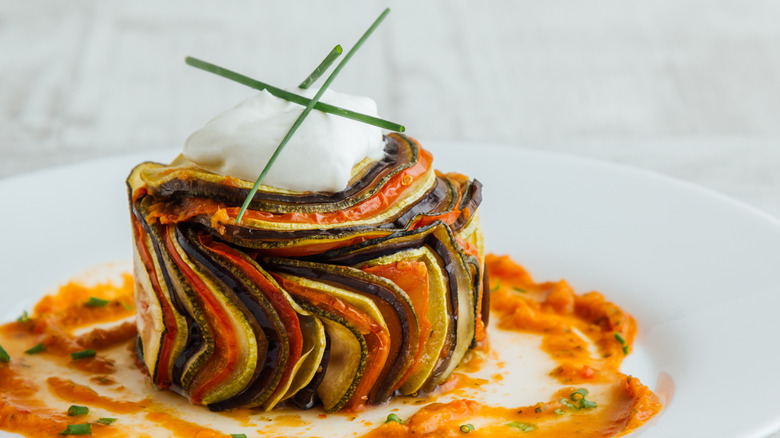What's The Difference Between Ratatouille And Confit Byaldi?
French cuisine is not monolithic but rather a patchwork that reflects regional influences of terroir, climate, and culture. That is abundantly clear when you compare Parisian cuisine to the cooking of Provence, in the south of France, where the fertile land, warm climate, and proximity to the Mediterranean coast inform a cuisine that overflows with vibrant, fresh flavors.
This is the land of lamb cooked over an open fire with thyme and rosemary, garlicky aioli, herbaceous pistou, fragrant basil, and bouillabaisse that's redolent of the nearby sea — all complimented by rustic and sturdy wines like Marsanne, Grenache Blanc, Mourvedre, and Cinsault. The people of Provence mostly eat what the seasons, farms, and markets dictate, seeing little need to supplement the rich natural flavors of local ingredients. Herbs, olive oil, and garlic are often all that is needed for support in this sun-soaked cuisine.
Possibly the most famous of all Provencal dishes and one that highlights those qualities is ratatouille. It is summer transmogrified into edible form, a staple in home and restaurant kitchens of the region, and, as such, imminently interpretable. One such riff on ratatouille, confit byaldi, has garnered considerable press, but some purists may take umbrage with how the dish filters an inherently rustic dish through the lens of haute cuisine.
What is the true ratatouille?
Provence was long thought of as a backwater. Far removed from the capital, many Parisians took a dim view of their southern compatriots who had much more in common, culturally speaking, with their nearby Spanish and Italian neighbors. Despite its beauty and hospitable climes, the region was habited mainly by farms and sleepy fishing villages.
Thus, cooking in Provence wasn't influenced by the aristocratic tastes of more cosmopolitan diners and chefs. It was developed and matured under the watchful eye of mothers and grandmothers who passed down recipes and techniques that got tweaked along the way. Traditional ratatouille embodies this rustic style of cooking. Zucchini and summer squash are roughly chopped with eggplant, onions, tomatoes, peppers, and garlic before being fried in olive oil and stewed in their juices for hours in an oven. Of course, this technique and additions, such as thyme and basil, can vary from recipe to recipe, many of which claim to be le vraie ratatouille, though that likely doesn't exist.
One need only look at its history to understand how difficult it is to define succinctly. A BBC investigation notes that many of the current lineup of the dish's "classic" ingredients were once spurned imports — some were even considered inedible for some time after their arrival. Ratatouille, which gets its name from the French verb touiller meaning "to stir," likely existed before these new additions as a practical stew that included all that was available.
Ratatouille by any other name
For better or worse, most probably know about the dish because of the Disney-Pixar film "Ratatouille," which features an ambitious rat who dreams of becoming a chef in a famous Parisian bistro.To capture the essence of French cuisine and the culinary transformation and artistry deployed in a restaurant kitchen, the filmmakers turned to a chef widely considered one of the best in the world. Thomas Keller, the proprietor of the famed French Laundry in Napa Valley, was brought in to consult on the culinary elements of "Ratatouille." Producer Brad Lewis was dispatched to the kitchen of the French Laundry to absorb some of Keller's style and learn about the work of chefs and cooks. And it was Lewis who asked Keller to create a version of ratatouille as though he knew it was being served to a restaurant critic.
Confit byaldi is a dish that's an homage to the ingredients of ratatouille, but with a much-elevated technique. To prepare this haute version of the rustic classic, a piperade of peppers, onions, garlic, and tomatoes is first laid down in a baking dish or sheet, upon which rounds of eggplant, squash, zucchini, and tomatoes are fanned out sequentially. The dish is covered to steam for hours, then uncovered to broil and caramelize. A spread of the herby piperade encircles the neat mound of sliced vegetables, which is then topped with creme fraiche and a single chive or sometimes a tart balsamic vinaigrette.


